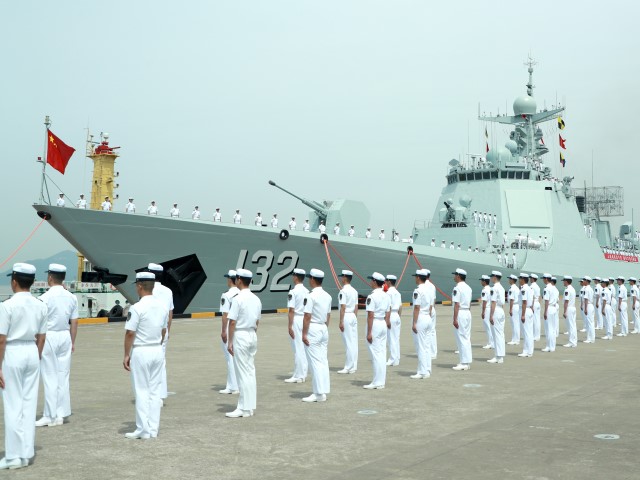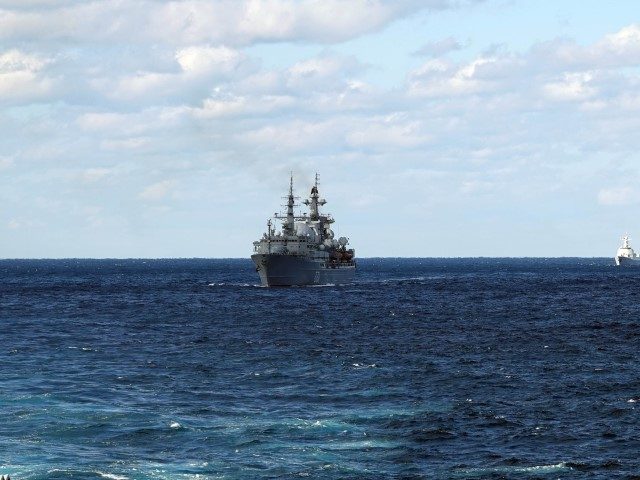Three Russian warships sailed through a contiguous maritime zone bordering Japanese territorial waters on Monday night, Japan’s Defense Ministry said Tuesday, noting that the ships traveled near the Japan-administered and China-claimed Senkaku Islands.
“The three vessels sailed north between the islands of Kubajima and Taishojima, part of the Senkaku chain in Okinawa Prefecture, toward the East China Sea,” Japan’s Defense Ministry said on July 5, as reported by Japan’s Nippon news website.
“One of the three vessels sailed in the contiguous zone Monday morning [July 4], which was followed by a Chinese warship, whose move drew a protest from the Japanese government,” Nippon noted on July 5.
The news outlet referred to an incident in which a Chinese warship apparently “chased” a Russian frigate for several minutes on the morning of July 4 near Japanese territorial waters surrounding the Senkakus.
“The Russian vessel stayed in the waters from 7:05 a.m. to 8:16 a.m. and appears to have done so to avoid a typhoon, a [Japan defense] ministry official said,” as quoted by Japan’s Kyodo News.
Japan’s government described the incident as “an apparent attempt [by China] to demonstrate to others that Beijing has sovereignty over the Tokyo-controlled islets [Senkakus].”
As noted by Nippon on Tuesday, Japan’s foreign ministry lodged an official protest over the July 4 maritime incident between Russia and China with Beijing, expressing “grave concern” over the matter.
“Japan refrained from protesting to Russia given that it does not lay claim to the islands and due to the Russian frigate apparently entering the contiguous zone to escape a typhoon,” a Japanese Foreign Ministry source said on Monday, according to Kyodo News.
Beijing lays claim to the Tokyo-administered Senkakus and refers to the uninhabited island chain as “Diaoyu.” The Senkakus are small islets that are strategically located near disputed natural gas deposits and Taiwan. The sovereign island nation of Taiwan is likewise claimed by Beijing as rightful Chinese territory.
Beijing has ordered various naval and coast guard vessels to sail through waters near Japan in recent weeks in what Tokyo interprets as a form of intimidation. China regularly harasses Japan near its Senkakus but has recently ramped up its activities in waters surrounding the islands to protest Tokyo’s increasingly public support for Taiwanese sovereignty.
A flotilla of Chinese Navy ships completed a circumnavigation of the Japanese archipelago on June 30 after first entering waters near Japan’s Tsushima Strait on June 12. The ships ended their journey near Taiwan, Kyodo News reported at the time.

Members of the Chinese Navy stand on the deck of the guided-missile destroyer Suzhou (Hull 132) of the escort taskforce at a military port on May 18, 2022, in Zhoushan, Zhejiang Province of China. (VCG/VCG via Getty Images)
The Tokyo-based news agency detailed the mission by the Chinese People’s Liberation Army Navy (PLAN), reporting:
Two [Chinese] guided-missile destroyers and a supply ship sailed through waters between Okinawa’s main island and Miyako Island in southwest Japan and entered the East China Sea Thursday [June 30] after circling around the country for about 20 days, and the ministry is analyzing China’s intentions, according to the [Japan defense] ministry’s Joint Staff.
Japan’s Self-Defense Forces vessels and aircraft had kept a vigilant watch for the Chinese navy’s flotilla, which was spotted sailing in the Sea of Japan after passing through the Tsushima Strait off Japan’s southern island of Kyushu from June 12 to 13 and going around the archipelago clockwise, according to the Joint Staff.
Japan’s defense ministry said on July 5 that it had spotted one of the PLAN vessels that recently circumnavigated the Japanese archipelago in waters near the Senkakus.
“[A] Chinese reconnaissance vessel sailed north between Okinawa’s main island and the island of Miyakojima Tuesday morning [July 5]. The vessel has circumnavigated the Japanese archipelago since June,” Japan’s Nippon news outlet reported.
Russian warships also recently completed a half circumnavigation around the Japanese archipelago, according to Nippon. The news website recalled on Tuesday that Japan’s government sighted a Russian naval flotilla sailing “off the southeastern coast of Hokkaido, Japan’s northernmost prefecture, on June 15,” adding that this unit “later went half around the Japanese archipelago.”
Russia and China have coordinated in recent weeks to conduct joint military drills near Japan. The two nations organized a flyover of “four Chinese H-6 bombers and two Russian Tu-95 bombers […] around Japan and the Republic of Korea” on May 24, USNI News reported.
“The joint flights took place the same day U.S. President Joe Biden was meeting his Australian, Indian and Japanese Quad grouping counterparts in Tokyo, though both the Russian and Chinese defense ministries stated that the flights were part of their annual military cooperation plan and not directed towards anyone,” the U.S. naval news website noted at the time.
Japan’s government reported on July 5 that two Chinese coast guard vessels had intruded into Japanese territorial waters near the Senkakus earlier that day and harassed a Japanese fishing boat.
“The Japan Coast Guard said the intrusion, the 15th this year and the first since June 23, happened around 4:35 a.m. after the Chinese ships tracked a Japanese fishing boat,” Kyodo News reported.
“The patrol vessels ordered the two Chinese ships to immediately exit the waters near the group of uninhabited islets,” according to the news agency.
Japan and Russia are technically in a state of war, as the two countries never signed a peace deal in the aftermath of World War II. They have failed to do so largely due to failing to resolve a separate maritime dispute over the Kuril Islands, which Russia administers but Japan claims.

COMMENTS
Please let us know if you're having issues with commenting.